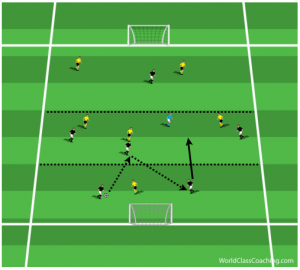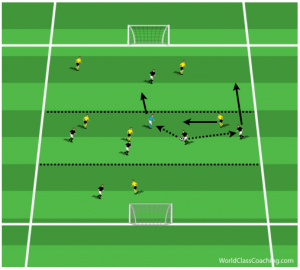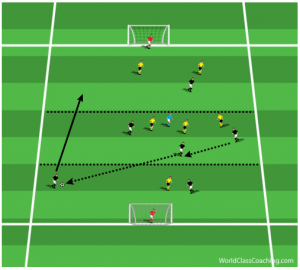By Sean Pearson
Area Size: 40 x 45 Yards
Teams: 6 v 6 (+1)
Time: 20 Minutes
Objectives
- To understand when and where to run with the ball
- To use running with the ball as a form of attack and advance the ball forwards
- To understand how far to run with the ball
The area is split into three zones each 15 yards in depth. In the defending zone have 2 defenders, in the middle have 3 midfielders and in the attacking zone have 1 striker. Initially players should stay in their zones when they do not have the ball, they are allowed to move zones if they have the ball, the ball can move into any zone at any time.
The objective is for your players to understand who can run with the ball, where they should/can run with it, why they run with it and when they can run with it. To start with focus on the two defenders. Most coaches will tend not to like their defenders to ‘dribble’ out from the back, however this is not dribbling. I like to encourage my players to be brave in possession and if space opens up in front of them, then to take it and come forwards. In the defending zone you outnumber the opposition and more options to run with the ball become available. Because you will also have an overload in midfield, due to the neutral, tell your players to spread out.
This leaves 4 players to be covered by 3. When the opposition are spread out and one of your defenders has time and space in front of them, this is the time to dribble into the next zone. If there is no space in front of them, tell them to keep the ball moving with passes into the midfield and back until this scenario presents itself. Do not force it if it is not there.
As the defender enters the midfield zone they will be closed down by an opposing player. It is now 5 v 3 in the middle zone so two players should be unmarked to be able to pass to. Encourage the player who receives the ball, if they are able, to run forwards into the attacking zone.
If a defender has not entered the middle zone, it is still 4v3 in the middle. Look to move the ball until a player is able to move the ball into the next zone by running with the ball. A visual cue for this is if there is space directly in front of them in the zone ahead.
Next, explain when the ball is on one side of the field and the area is congested, first that the ball should be switched to the other side, but also if the player receiving can, they should ‘drive’ the ball forward until pressured. This happens most on the wings. I encourage my team to use the verbal cue of drive to the player on the ball to communicate that the scenario is ‘on’ for running with the ball, with speed, up the field.
Make your players aware that this can also occur in the middle of the field, if a center midfielder finds themselves with space in front of them, they can run with the ball to attack.
Coaching Points
- To use the visual cue of space ahead to decide quickly to run with the ball into it
- To know how far to run with the ball and when to pass/shoot
- Move the ball until the scenario presents itself rather than force something that is not there and ‘dribble’ if it is unnecessary.
Variations/Progressions
- Do not have a neutral
- Add GKers
- When an attacking player moves into the next zone a defending player can come with them to apply pressure from behind
- Allow free movement with 1 point awarded if players run with the ball from one zone to another and 2 if they are able to run into 2 zones
- A goal can only be scored if a player has ran with the ball into another zone
By Sean Pearson
By Sean Pearson. Sean is also the author Coaching Team Shape in the 3-3-1, Coaching Team Shape in the 4-2-3-1 and Coaching Team Shape in the 4-3-3





